
Howittia is a genus of plant containing the single species, Howittia trilocularis, commonly known as blue howittia, and is endemic to Australia. It is a tall shrub found growing in shaded valleys and on rainforest edges, it has hairy leaves and single, purple flowers.

Olearia phlogopappa commonly known as the dusty daisy-bush or alpine daisy-bush is a species of flowering plant in the family Asteraceae that is commonly found in eastern New South Wales, Victoria and Tasmania. It is a small shrub with greyish-green foliage, daisy-like flowers in white, pink or mauve that can be seen from spring to late summer.

Prostanthera ovalifolia, commonly known as the oval-leaf mintbush or purple mintbush, is a species of flowering plant in the family Lamiaceae and is endemic to south-eastern continental Australia. It is an erect shrub with egg-shaped leaves and groups of mauve to deep blue-purple flowers arranged in groups at the ends of branchlets.
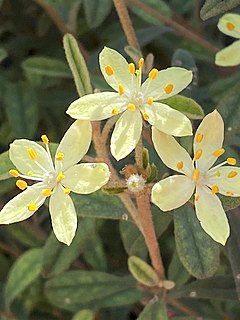
Asterolasia asteriscophora, commonly known as lemon starbush, is a species of slender, erect shrub in the family Rutaceae and is endemic to southern continental Australia. It has woolly, star-shaped hairs on its young branches, variably-shaped leaves covered with brownish or whitish hairs on the underside, and yellow flowers with woolly brown, star-shaped hairs on the back.

Prostanthera cryptandroides is a species of flowering plant in the family Lamiaceae and is endemic to eastern Australia. It is a low, spreading shrub with narrow egg-shaped leaves and lilac to mauve flowers arranged singly in leaf axils.

Olearia asterotricha, commonly known as rough daisy-bush, is a species of flowering plant in the family Asteraceae. A tall shrub with white, mauve or blue daisy like flowers growing from the Blue Mountains in New South Wales to western Victoria, Australia.
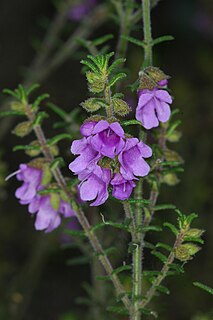
Prostanthera decussata, commonly known as dense mintbush, species of flowering plant that is endemic south-eastern Australia. It is a dense, compact, strongly aromatic shrub with egg-shaped leaves and mauve to violet flowers with yellow streaks, arranged in leaf axils near the ends of branchlets.

Prostanthera denticulata, commonly known as rough mint-bush, is a species of flowering plant in the family Lamiaceae and is endemic to south-eastern continental Australia. It is a straggling to almost prostrate, aromatic shrub with narrow egg-shaped leaves and purple to mauve flowers arranged in leaf axils or on the ends of branchlets.
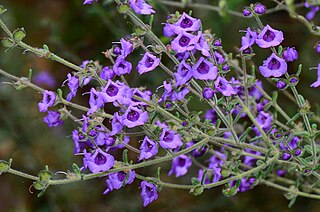
Prostanthera hirtula, commonly known as hairy mintbush, is a species of flowering plant in the family Lamiaceae and is endemic to the south-eastern continental Australia. It is a strongly aromatic, densely hairy, spreading shrub with narrow egg-shaped leaves and dark mauve flowers, and that grows in exposed, rocky sites.

Prostanthera saxicola is a species of flowering plant in the family Lamiaceae and is endemic to eastern Australia. It is a shrub with linear to elliptic leaves and white to mauve flowers arranged in leaf axils.

Grevillea raybrownii is a flowering shrub in the family Proteaceae and is endemic to New South Wales. It has divided, pointed leaves and dense clusters of flowers usually at the end of branches.
Eremophila ciliata, commonly known as Archer's eremophila is a flowering plant in the figwort family, Scrophulariaceae and is endemic to a small area in the south of Western Australia. It is an erect, spreading shrub with short, thick leaves and small lilac to mauve flowers. It is only known from a population of about 100 plants.
Eremophila crassifolia, commonly known as thick-leaved emubush or trim emubush, is a flowering plant in the figwort family, Scrophulariaceae and is endemic to an area extending from New South Wales through Victoria to southern parts of South Australia. It is a low, spreading shrub with clustered leaves and bell-shaped, usually mauve-coloured flowers.
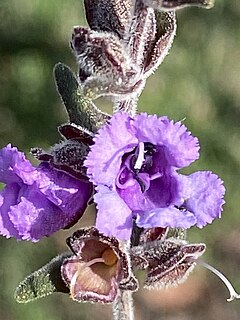
Prostanthera howelliae is a flowering plant in the mint family Lamiaceae and is endemic to New South Wales and Queensland. It is a small shrub with narrow stems, aromatic, hairy leaves and violet-coloured, tube-shaped flowers.
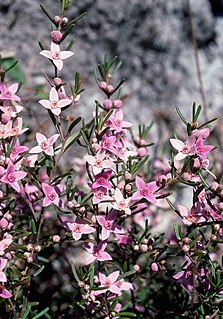
Boronia rosmarinifolia, commonly known as the forest rose, is a plant in the citrus family Rutaceae and is endemic to eastern Australia. It is a shrub with many branches, simple leaves and pale to bright pink flowers arranged singly in leaf axils.
Olearia aglossa, is a shrub in the family Asteraceae and is found in mountainous terrain in New South Wales and Victoria in Australia. It is a small shrub with spreading upright branches and white daisy-like flowers.
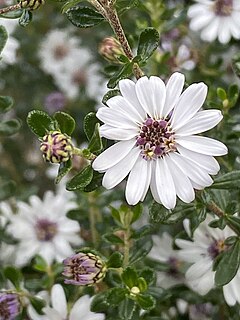
Olearia minor, is a small flowering shrub in the family Asteraceae. It has alternate leaves and white to pale mauve daisy-like flowers from winter to December. It grows in Western Australia, South Australia, New South Wales, and Victoria.
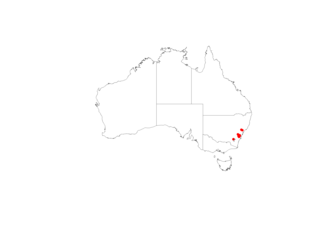
Prostanthera rugosa is a species of flowering plant in the family Lamiaceae and is endemic to a restricted area of New South Wales. It is an openly-branched shrub with egg-shaped or narrow egg-shaped, thick, fleshy leaves and mauve flowers with a white tinge arranged in leaf axils near the ends of branchlets.

Prostanthera sericea, commonly known as silky mintbush or walyuwalyu, is a species of flowering plant in the family Lamiaceae and is endemic to inland Australia. It is an erect shrub with hairy branches, cylindrical leaves and white flowers with mauve or purple streaks.

Dampiera rosmarinifolia, commonly known as rosemary dampiera, is a flowering plant in the family Goodeniaceae.It is a perennial subshrub with linear leaves, mauve or purple flowers borne in leaf axils.

















